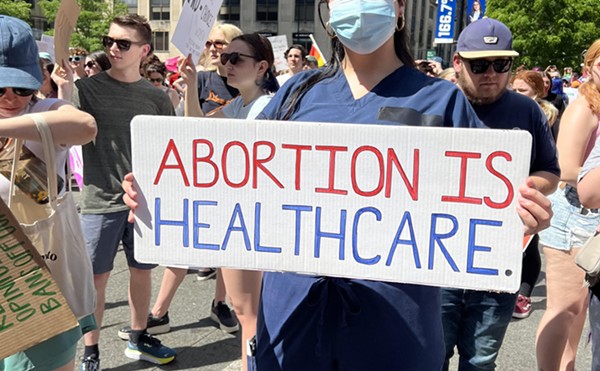If only the artwork addressing prejudice could more closely emulate prejudice itself, suddenly rearing up in our paths or flying at us from our blind spots to decimate what we know about ourselves.
Instead, part of the exhibit Facing Prejudice is safely stationed in an alcove at the entrance of the University of Dayton's Roesch Library, while downstairs in the smaller Ryan C. Harris Learning Teaching Center students are forced to feed through another section of the exhibit.
Instead of actively accosting viewers, the exhibit seeks to disarm them.
"We really wanted to make sure that people who walked through could find themselves represented in one of the stories, but find themselves not faced with being overwhelmed, but finding a way to really move themselves to action," says Shawn Jeffers, education coordinator for the Center for Holocaust and Humanity Education.
Jeffers was the center's project manager for the exhibit, a joint 2004 project initiated by the CHHE and executed by senior graphic design students in the University of Cincinnati College of Design, Art, Architecture and Planning (DAAP).
After its June 2004 debut at daapWorks and stops at the National Underground Railroad Freedom Center and Thomas More College, Facing Prejudice is now showing at the University of Dayton.
John Rizzo, a 2004 graduate of DAAP, was one of 28 students who developed the exhibit.
"We were told our topic was 'Prejudice: Go!' " he says.
"The topic of prejudice was a very difficult topic," says Kristin Cullen, an associate professor of graphic design at DAAP.
"It is diverse and covers an innumerable range of considerations. Attempting to understand the topic, conceive a direction and focus was an enormous task."
The 28 students served on both design teams and production committees and did nearly everything, from research, interviews and original photography to managing the budget and physically assembling the exhibit.
Every section ends in "everyday," such as "Hate Speech Everyday," because they wanted to "make it a daily battle type of deal," Rizzo says. "We tried to get the categories of prejudice and why people are prejudiced and how we can fight it."
Under every section heading is an interrupting graphic bar, which designers called a "violator bar," "to show the continuity of prejudice through different areas," Rizzo says. Those areas include hate speech, violence, xenophobia, inequity, silence, the tension between insiders and outsiders, tolerance, discrimination and stereotypes.
A "Silence Everyday" panel addresses the tacit permission granted when witnesses to acts of prejudice hold their tongues. Text is superimposed over photographic images of an empty auditorium and unmanned microphone.
Another section addressing "Xenophobia Everyday" asks, "Why is it difficult to welcome someone new into a group" — a phenomenon well-known to many residents new to Cincinnati.
The students also addressed types of prejudices that don't usually get a lot of attention. For instance, one part of the exhibit points out, "Most overweight children are five times as likely to have low self-confidence." Another section says that 36 percent of gay youth attempt suicide at least once and that American schools harbor 3.7 million bullies.
Anecdotes soften those sterile statistics. For example, this one: Jackie Robinson, the first African American to play Major League Baseball, was routinely subject to heckling from the stands. Once an entire Cincinnati stadium started hissing at Robinson — until Dodgers team captain Pee Wee Reese slung an arm around Robinson; the hissing instantly stopped.
Interspersed among historical anecdotes and statistics are more personal observations.
"This project got me back in touch with my own prejudice and the effects prejudice had in my life," says one.
Another says, "I am not afraid to call people out on their bad jokes."
Associated with each section are "action cards" visitors can take away. On the back of each are challenge statements; for example, one of the three on the back of the "Inequity Everyday" action card says, "I will not expect life to be fair, but I will always try to act fairly. I will try to be a role model for fairness." That flier uses a playing card motif to invoke hands of cosmic luck.
Although the project was commissioned by the CHHE, little of the exhibit focuses on the Holocaust or anti-Semitism. That's fine by Jeffers, who says it's more important to reach every group and dispel the notion that education is, by definition, a shield from prejudicial impulses — a message especially relevant in university settings.
"We assume that prejudice comes from ignorance," Jeffers says. "But the Holocaust shows us that the educated individuals are just as capable of creating prejudice and creating intolerance."





